To elevate your chai tea blend, consider adding these bold spices: cardamom pods, black peppercorns, star anise, fennel seeds, cloves, coriander seeds, allspice berries, nutmeg, dried ginger root, and turmeric powder. Each spice brings a unique flavor profile and potential health benefits. Cardamom offers an authentic chai taste, while black pepper adds a fiery kick. Star anise and fennel provide licorice notes, and cloves bring warmth. Coriander adds a citrusy touch, allspice combines multiple flavors, and nutmeg contributes aromatic essence. Dried ginger root delivers a spicy punch, and turmeric introduces earthy warmth. Discover how these spices can transform your chai experience.
Cardamom Pods

Cardamom pods are the star player in any chai tea blend. These small, green pods pack a powerful punch of flavor that's both sweet and spicy. When you're crafting your chai, don't skimp on cardamom – it's the key to achieving that authentic taste.
To use cardamom pods, you'll want to lightly crush them to release their oils. This will help infuse your tea with their unique flavor profile. You can do this by gently pressing them with the flat side of a knife or using a mortar and pestle. Don't overdo it, though; you're aiming to crack the pods, not pulverize them.
For a standard cup of chai, start with 2-3 cardamom pods. As you become more familiar with the spice, you can adjust the amount to suit your taste. Remember, cardamom's flavor can be quite intense, so it's best to start conservatively and work your way up.
When steeping your chai, allow the cardamom pods to simmer with the other spices for at least 5-10 minutes. This will guarantee you extract the full depth of flavor from these aromatic gems.
Black Peppercorns
Among the bold spices in a chai tea blend, black peppercorns stand out for their sharp, fiery kick. These tiny, round berries pack a powerful punch that'll awaken your senses and add depth to your chai. When you're crafting your blend, don't shy away from these pungent gems. They'll provide a subtle heat that lingers on your palate, complementing the sweetness of other spices.
To get the most out of black peppercorns in your chai, you'll want to use whole ones and crush them just before brewing. This guarantees maximum flavor and aroma. You can use a mortar and pestle or the back of a spoon to crack them open. The coarseness of the grind will affect the intensity of the pepper flavor, so experiment to find your perfect balance.
Black peppercorns in chai tea create:
- A warming sensation that spreads through your chest
- A subtle, spicy undertone that cuts through the milk's richness
- A pleasant tingle on your tongue, enhancing the overall taste experience
Star Anise
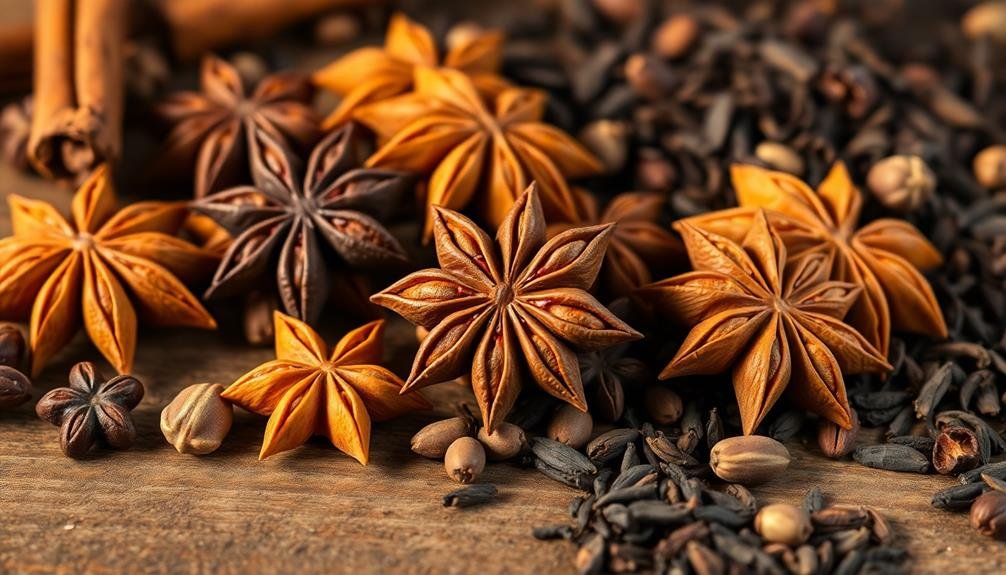
You'll instantly recognize star anise by its distinctive licorice flavor that adds depth to your chai blend.
Its unique star shape makes it a standout ingredient, elevating the visual appeal of your spice mix.
When you're crafting your chai, consider leaving a few whole star anise pods visible in the blend for an eye-catching presentation.
Distinctive Licorice Flavor
Star anise adds a distinctive licorice flavor to chai tea blends, elevating the warm spice profile with its sweet and pungent notes. You'll find that this star-shaped spice brings depth and complexity to your chai, complementing the other bold ingredients perfectly. Its unique flavor is due to a compound called anethole, which is also found in fennel and anise seeds.
When you're crafting your chai blend, consider using whole star anise pods for a more intense flavor. You can crush them slightly before adding them to your mix to release their aromatic oils. If you prefer a milder taste, ground star anise is an excellent alternative. Remember that a little goes a long way – start with small amounts and adjust to your liking.
Star anise not only enhances the taste of your chai but also offers potential health benefits. It's known for its:
- Antioxidant properties
- Digestive aid capabilities
- Antimicrobial effects
You'll find that star anise pairs exceptionally well with cinnamon, ginger, and cardamom in your chai blend. Its licorice notes create a pleasant contrast to the spicy and warm flavors, resulting in a well-rounded and satisfying cup of tea.
Experiment with different ratios to find your perfect balance of flavors.
Visual Appeal Factor
Beauty isn't just for the eyes when it comes to chai tea blends. Star anise, with its distinctive eight-pointed star shape, adds a stunning visual element to your mix. You'll find that this spice not only enhances the flavor profile but also creates an Instagram-worthy presentation.
When you're crafting your chai blend, consider how star anise can elevate its appearance. The spice's deep brown color and unique form provide a striking contrast against lighter ingredients. You can use whole star anise or break it into smaller pieces for varied textures.
Here's a quick guide to incorporating star anise for visual appeal:
| Presentation | Whole | Broken | Ground |
|---|---|---|---|
| Dry Blend | ✓ | ✓ | ✗ |
| Brewed Tea | ✓ | ✗ | ✗ |
| Garnish | ✓ | ✗ | ✗ |
| Packaging | ✓ | ✓ | ✗ |
Fennel Seeds
Fennel seeds bring a sweet and licorice-like flavor to your chai tea blend. These tiny, pale green seeds add a unique dimension to the traditional spice mix, offering a rejuvenating contrast to the warmth of cinnamon and the heat of ginger.
When you're crafting your chai blend, consider adding fennel seeds to create a more complex and intriguing flavor profile. To use fennel seeds effectively, you'll want to crush them lightly before adding them to your blend. This releases their essential oils and enhances their aroma.
Start with a small amount, about 1/4 teaspoon per cup of tea, and adjust to your taste preferences. You can increase the quantity for a more pronounced licorice flavor or decrease it for a subtler touch.
Fennel seeds not only contribute to the taste of your chai but also offer potential health benefits. They're known to:
- Aid digestion and reduce bloating
- Freshen breath naturally
- Support respiratory health
Experiment with fennel seeds in your chai blend to discover how they interact with other spices. You might find they pair particularly well with cardamom or star anise, creating a harmonious balance of flavors that elevates your chai experience to new heights.
Cloves
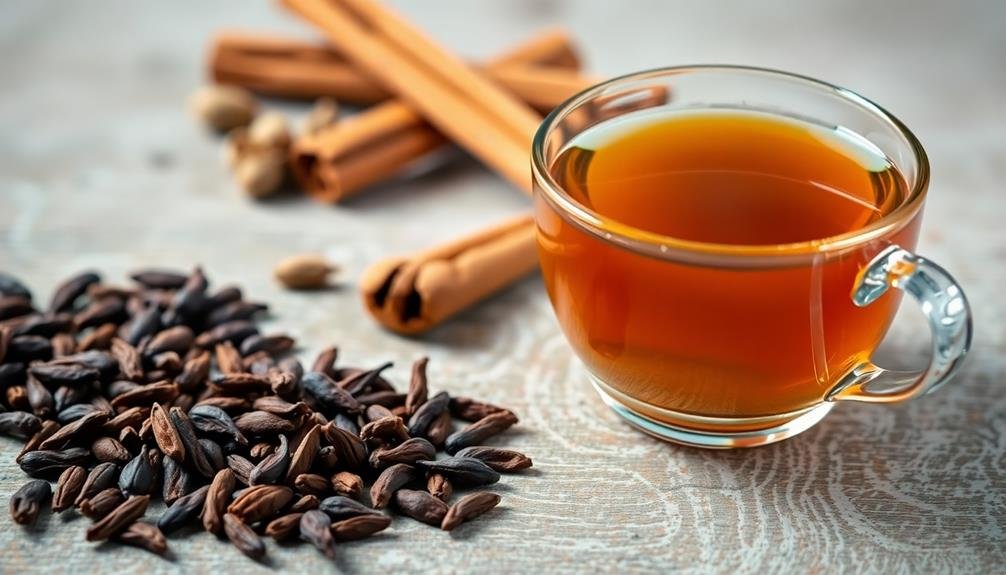
Cloves stand out as one of the most potent spices in a chai tea blend. These tiny, nail-shaped buds pack a powerful punch, adding a warm, sweet, and slightly bitter flavor to your chai. You'll recognize cloves by their intense aroma and distinct appearance.
When using cloves in your chai, remember that a little goes a long way. Start with just a few buds per cup, as their strong flavor can quickly overpower other spices. You can either add whole cloves directly to your tea mixture or grind them for a more intense flavor. If you're using whole cloves, remove them before drinking to avoid an unpleasant surprise.
Cloves offer more than just flavor; they're also known for their potential health benefits. They contain eugenol, a compound with anti-inflammatory and antioxidant properties. Some people believe cloves can help with digestion, reduce nausea, and even provide pain relief.
To get the most out of your cloves, store them in an airtight container in a cool, dark place. This will help preserve their potent flavor and aroma for longer.
When selecting cloves, choose ones that are dark brown and feel oily to the touch for the freshest taste.
Coriander Seeds
You'll find coriander seeds adding a unique citrusy and slightly nutty flavor to your chai blend, along with a warm, inviting aroma.
These small, round seeds pack a punch of potential health benefits, including digestive support and antioxidant properties.
To get the most out of coriander seeds in your chai, lightly crush them before adding to your blend, allowing their essential oils to release and infuse your tea with their distinctive taste.
Flavor Profile and Aroma
Coriander seeds bring a unique citrusy and slightly nutty flavor to chai tea blends. You'll notice their aromatic presence as soon as you open your spice jar, with a warm, inviting scent that's both earthy and sweet. When added to chai, coriander seeds impart a subtle complexity that complements the other spices perfectly.
As you sip your chai, you'll experience the coriander's flavor profile evolving. Initially, you'll taste bright, lemony notes that awaken your palate. This citrusy zing then gives way to a mellow, nutty undertone that adds depth to the tea. The seeds' gentle warmth lingers, enhancing the overall spiciness of your chai without overpowering other ingredients.
To fully appreciate coriander's impact on your chai, imagine:
- Sunlight streaming through lemon trees in an orchard
- The earthy aroma of freshly cracked nuts
- A warm breeze carrying hints of exotic spices
Coriander's versatility makes it an excellent addition to your chai blend. It balances the sharpness of ginger and black pepper while harmonizing with sweeter spices like cinnamon and cardamom.
Health Benefits Overview
Beyond their aromatic appeal, coriander seeds offer a range of health benefits that make them a valuable addition to your chai blend. These tiny, round seeds pack a powerful punch when it comes to supporting your overall health.
They're rich in antioxidants, which help protect your cells from damage caused by free radicals. You'll also find that coriander seeds can aid in digestion by stimulating the production of digestive enzymes and reducing bloating and discomfort.
If you're looking to manage your blood sugar levels, coriander seeds might help. They've been shown to potentially lower blood glucose levels and improve insulin sensitivity.
You'll be pleased to know that these seeds may also contribute to heart health by helping to reduce cholesterol levels and regulate blood pressure. Additionally, coriander seeds possess anti-inflammatory properties, which can be beneficial for various chronic conditions.
They're also a good source of iron, magnesium, and calcium, supporting bone health and preventing anemia. By incorporating coriander seeds into your chai blend, you're not just enhancing the flavor but also boosting your drink's nutritional value and potential health benefits.
Preparation and Usage Tips
Now that you're aware of coriander seeds' health benefits, let's focus on how to prepare and use them in your chai blend. Start by lightly toasting whole coriander seeds in a dry pan over medium heat for 1-2 minutes. This releases their essential oils and enhances their flavor.
Once cooled, grind the seeds using a mortar and pestle or spice grinder. For a standard chai recipe, use 1/2 teaspoon of ground coriander per cup of tea.
When incorporating coriander into your chai blend, remember that it pairs well with other warm spices like cinnamon, cardamom, and ginger. Experiment with different ratios to find your perfect balance.
To brew, add your spice blend to boiling water and steep for 5-7 minutes before adding milk and sweetener to taste.
For a unique twist on traditional chai, try these coriander-infused variations:
- Lemon-Coriander Chai: Add a splash of fresh lemon juice for a bright, citrusy note
- Coconut-Coriander Chai: Use coconut milk instead of regular milk for a tropical flavor
- Chocolate-Coriander Chai: Stir in a teaspoon of cocoa powder for a rich, indulgent treat
Store your ground coriander in an airtight container away from light and heat to maintain freshness.
Allspice Berries
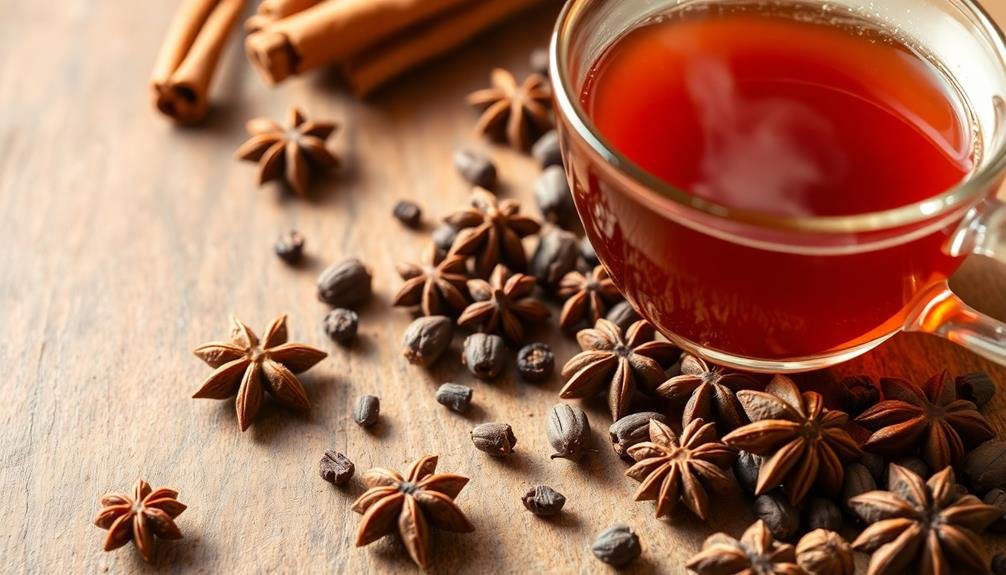
Although often mistaken for a blend of spices, allspice berries are actually the dried fruit of the Pimenta dioica tree. Native to the Caribbean and Central America, these small, dark brown berries pack a powerful punch of flavor that can elevate your chai tea blend. Allspice combines the tastes of cinnamon, nutmeg, and cloves, making it a versatile addition to your spice repertoire.
When using allspice in your chai blend, you'll want to opt for whole berries rather than ground powder. The berries retain their essential oils better, ensuring a more robust flavor and longer shelf life. To incorporate allspice into your chai, gently crush a few berries before adding them to your tea mixture. This releases the oils and allows the flavors to infuse more effectively.
Allspice pairs particularly well with other chai staples like cardamom, ginger, and black pepper. Its warm, slightly sweet profile adds depth and complexity to your brew.
You can adjust the amount of allspice to suit your taste preferences, but remember that a little goes a long way. Start with one or two berries per cup and increase as desired.
Nutmeg
The warm, aromatic essence of nutmeg can transform your chai tea blend into a sensory delight. This versatile spice adds depth and complexity to your brew, enhancing the overall flavor profile.
When you're crafting your chai, grate a small amount of fresh nutmeg directly into the mix for the best results. You'll notice its sweet, woody notes complementing the other spices perfectly.
Nutmeg pairs exceptionally well with cinnamon and cardamom, two staples in most chai recipes. It's also known for its warming properties, making it an ideal addition to your cozy cup during colder months.
Don't overdo it, though – a little goes a long way. Too much nutmeg can overpower the other flavors and even cause a slight numbing sensation on your tongue.
To fully appreciate nutmeg's contribution to your chai, try these sensory exercises:
- Close your eyes and inhale deeply, letting the nutmeg's aroma transport you to a spice market
- Take a small sip and let it linger, focusing on the subtle nutty undertones
- Observe the tiny specks of grated nutmeg swirling in your cup, adding visual interest
Dried Ginger Root
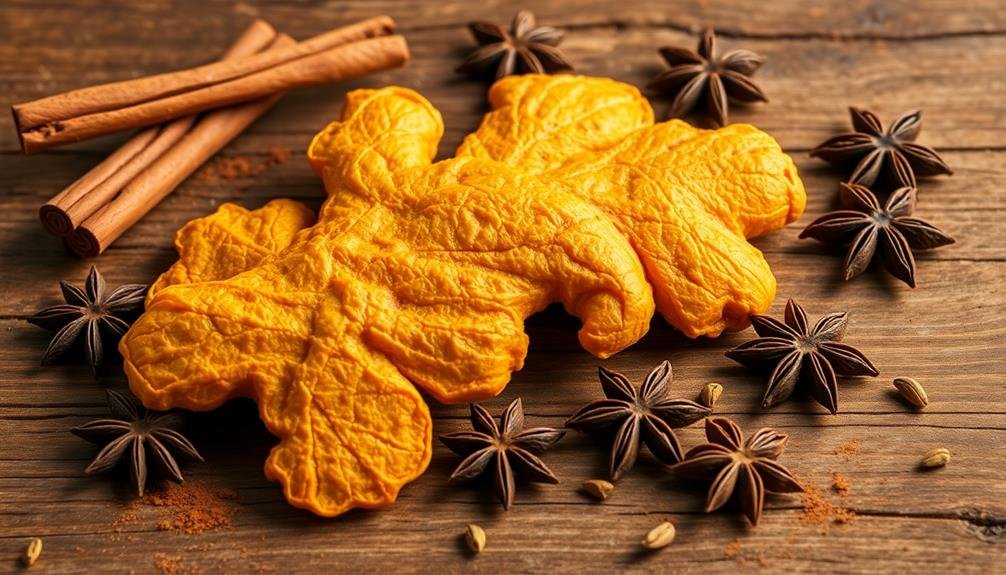
You'll find dried ginger root adds an intense warmth and spicy kick to your chai tea blend.
It's not just for flavor though – ginger can aid digestion and soothe upset stomachs.
When using dried ginger, you'll need to decide whether to grind it into a powder or use whole pieces, each offering a different intensity and infusion rate.
Intense Warmth and Spice
Dried ginger root packs a powerful punch in any chai tea blend, delivering intense warmth and spice. You'll immediately notice its fiery kick and aromatic presence as it infuses into your brew. This versatile spice not only adds depth to your chai but also offers numerous health benefits, including anti-inflammatory properties and digestive aid.
When selecting dried ginger for your blend, opt for high-quality pieces that are firm and free from mold. Grind them fresh for maximum potency, or use pre-ground ginger for convenience. Experiment with different amounts to find your perfect balance of heat and flavor.
To fully appreciate the intense warmth and spice of dried ginger in your chai, imagine:
- The tingling sensation on your tongue as you take your first sip
- The comforting warmth spreading through your body on a chilly day
- The invigorating aroma wafting from your steaming cup
Pair dried ginger with complementary spices like cardamom, cinnamon, and black pepper to create a well-rounded chai blend. You'll find that the ginger's intensity harmonizes beautifully with the sweetness of your chosen milk and sweetener, resulting in a truly satisfying and invigorating beverage.
Digestive Aid Properties
Why is dried ginger root so prized for its digestive aid properties? This potent spice has been used for centuries to soothe upset stomachs and promote healthy digestion. When you add dried ginger to your chai blend, you're not just enhancing the flavor; you're also amplifying its health benefits.
Ginger contains compounds like gingerols and shogaols, which can help reduce inflammation and ease nausea. It's particularly effective in combating motion sickness, morning sickness, and general digestive discomfort. By incorporating dried ginger into your chai, you'll create a warming, comforting beverage that also supports your digestive system.
| Digestive Issue | How Ginger Helps |
|---|---|
| Nausea | Calms stomach |
| Bloating | Reduces gas |
| Indigestion | Stimulates digestion |
| Cramping | Relaxes intestines |
| Inflammation | Anti-inflammatory |
To maximize the digestive benefits of ginger in your chai, use freshly ground dried ginger root. This guarantees you're getting the most potent form of the spice. Start with a small amount and adjust to your taste preferences. Remember, a little goes a long way with dried ginger, so use it sparingly to avoid overpowering your blend.
Grinding vs. Whole Pieces
The choice between grinding dried ginger root and using whole pieces can significantly impact your chai's flavor profile and potency. When you grind ginger, you'll release its oils and increase the surface area, resulting in a more intense, spicier flavor that infuses quickly into your tea. This method works well if you're looking for a bold, immediate ginger kick.
On the other hand, using whole pieces of dried ginger root offers a more subtle, gradual release of flavor. You'll experience a gentler infusion that develops over time, allowing the ginger to harmonize with other spices in your chai blend. Whole pieces also make it easier to control the intensity, as you can remove them once you've achieved your desired flavor strength.
Consider these sensory elements when deciding:
- The sharp, zingy aroma of freshly ground ginger
- The satisfying crunch of whole ginger pieces as you scoop them into your tea
- The visual appeal of floating ginger slices in your cup
Ultimately, your choice depends on personal preference and the specific chai recipe you're crafting. Experiment with both methods to find the perfect balance for your taste buds.
Turmeric Powder
Vibrant yellow turmeric powder adds a warm, earthy flavor to chai tea blends. This potent spice not only enhances the taste but also brings numerous health benefits to your cup. When incorporating turmeric into your chai, start with a small amount—about 1/4 teaspoon per serving—and adjust to your liking.
You'll find that turmeric pairs well with traditional chai spices like cinnamon, cardamom, and ginger. It's best to add the powder during the brewing process, allowing it to fully infuse into the tea. Be aware that turmeric can stain, so use caution when handling it.
To boost turmeric's bioavailability, add a pinch of black pepper to your blend. This combination enhances the absorption of curcumin, the active compound in turmeric. For a creamier texture and to further increase absorption, consider adding a small amount of coconut oil or ghee to your chai.
Store your turmeric powder in an airtight container away from light and heat to maintain its potency. When selecting turmeric, opt for high-quality, organic varieties to guarantee the best flavor and health benefits in your chai tea blend.
Frequently Asked Questions
How Long Can I Store Homemade Chai Spice Blends?
You can store homemade chai spice blends for up to 6 months in an airtight container. Keep it in a cool, dark place to maintain freshness. For maximum flavor, use it within 3 months. Don't forget to label it!
Can I Use Ground Spices Instead of Whole Ones?
You can use ground spices for your chai blend, but they'll lose flavor faster than whole ones. If you're using ground spices, store them in an airtight container and use them within 3-6 months for the best taste.
What's the Ideal Ratio of Spices to Tea Leaves?
You'll want to start with a 1:4 ratio of spices to tea leaves. That's about 1 teaspoon of spices for every 4 teaspoons of tea. Adjust to your taste, making it stronger or milder as you prefer.
Are There Caffeine-Free Alternatives for Chai Spice Blends?
You'll find several caffeine-free alternatives for chai spice blends. Try using rooibos or honeybush as your base instead of black tea. You can also steep your favorite spices in hot water or milk for a comforting, caffeine-free chai experience.
How Can I Adjust the Spiciness Level of My Chai Blend?
You can adjust your chai blend's spiciness by varying the amount of ginger, black pepper, and cardamom. Add more for a spicier kick or reduce them for a milder flavor. Don't forget, you can always experiment with different ratios.
In Summary
You've now got a treasure trove of bold spices to transform your chai tea blend. Don't be afraid to experiment with different combinations and proportions. Remember, the beauty of chai lies in its versatility. Trust your taste buds and adjust as you go. Whether you're seeking warmth, spice, or a touch of sweetness, these ingredients will help you create a unique and satisfying chai experience. Enjoy your aromatic journey!

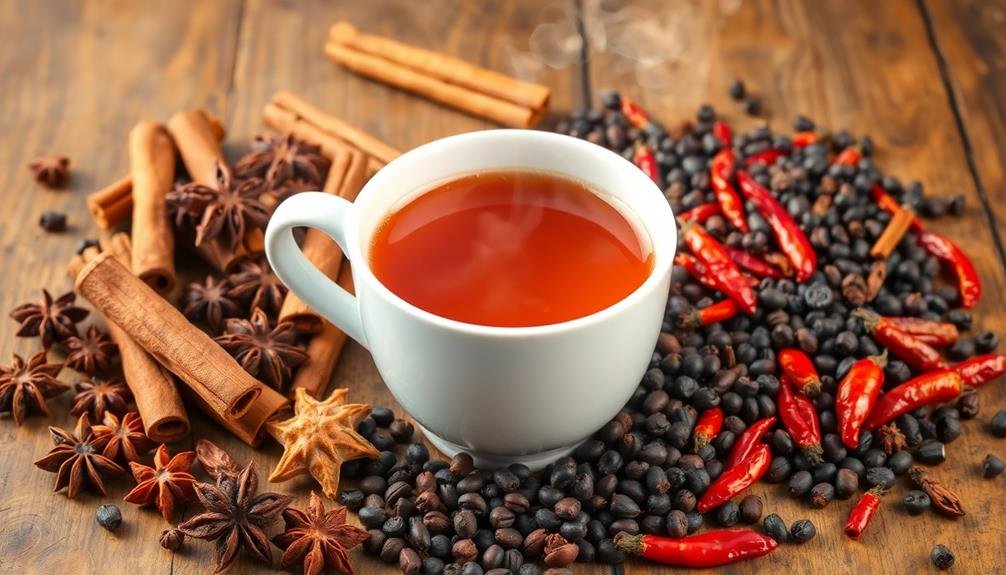



Leave a Reply